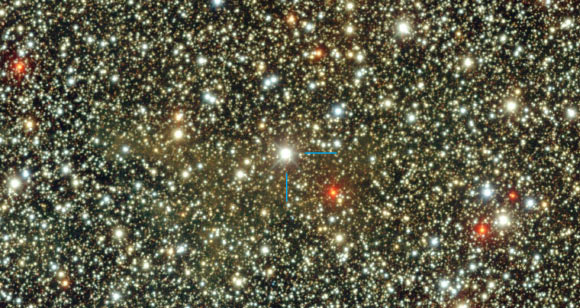MeerKAT Spots Huge Radio Flare from Binary System | Astronomy – Sci-News.com
Astronomers using the MeerKAT telescope at the South African Radio Astronomy Observatory have spotted an object which rapidly brightened by more than a factor of three over a period of three weeks. This is the first new ‘transient’ source discovered with MeerKAT.

This image shows TYC 8332-2529-1. Image credit: Centre de Données astronomiques de Strasbourg / SIMBAD / DECaPS.
Astronomers call an astronomical event ‘transient’ when it appears or disappears, or becomes fainter or brighter over seconds, days, or even years. These events are important as they provide a glimpse of how stars live, evolve, and die.
The source of the flare spotted by MeerKAT is a binary system called GX339−4, where two objects orbit each other every 21.25 days.
While the cause of the flaring and the exact nature of the stars that make up the system is still uncertain, it is thought to be associated with an active corona — the hot outermost part of the brighter star.
The source is located in the southern constellation of Ara and was found to be coincident with TYC 8332-2529-1, a giant star about two times as massive as the Sun.
Fortuitously, the star is sufficiently bright to have also been monitored by optical telescopes for the last 18 years and is seen to vary in brightness every three weeks, matching the orbital period.
“This source was discovered just a couple of weeks after I joined the team, it was amazing that the first MeerKAT images I worked on had such an interesting source in them,” said Laura Driessen, a Ph.D. student at the University of Manchester.
“Once we found out that the radio flares coincided with a star, we discovered that the star emits across almost the entire electromagnetic spectrum from X-ray to UV to radio wavelengths.”
“The properties of this system don’t easily fit into our current knowledge of binary or flaring stars and so may represent an entirely new source class,” said Professor Ben Stappers, also from the University of Manchester.
“Since the inauguration in July 2018 of the South African MeerKAT radio telescope, the ThunderKAT project on MeerKAT has been monitoring parts of the southern skies to study the variable radio emission from known compact binary stars, such as accreting black holes,” said Professor Patrick Woudt, an astronomer at the University of Cape Town.
“The excellent sensitivity and the wide field of view of the MeerKAT telescope, combined with the repeat ThunderKAT observations of various parts of the southern skies, allows us to search the skies for new celestial phenomena that exhibit variable or short-lived radio emission.”
The team’s paper appears in the Monthly Notices of the Royal Astronomical Society.
_____
L.N. Driessen et al. MKT J170456.2−482100: the first transient discovered by MeerKAT. MNRAS, published online October 30, 2019; doi: 10.1093/mnras/stz3027






